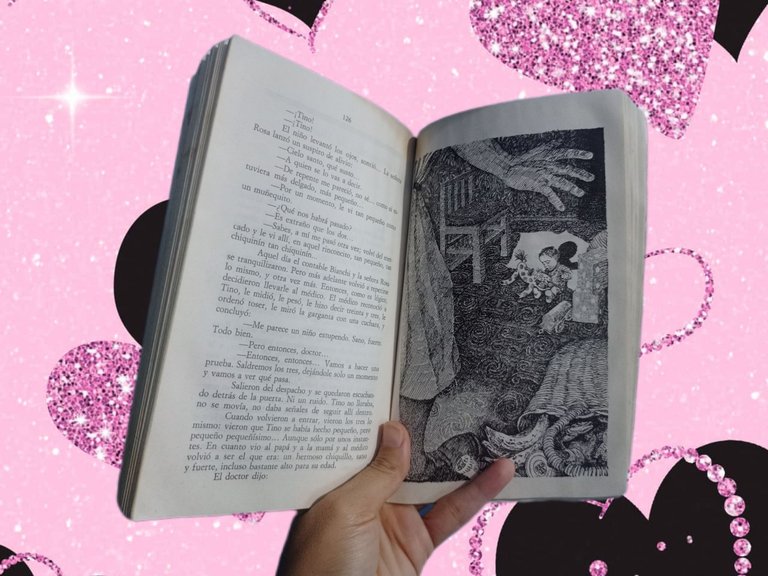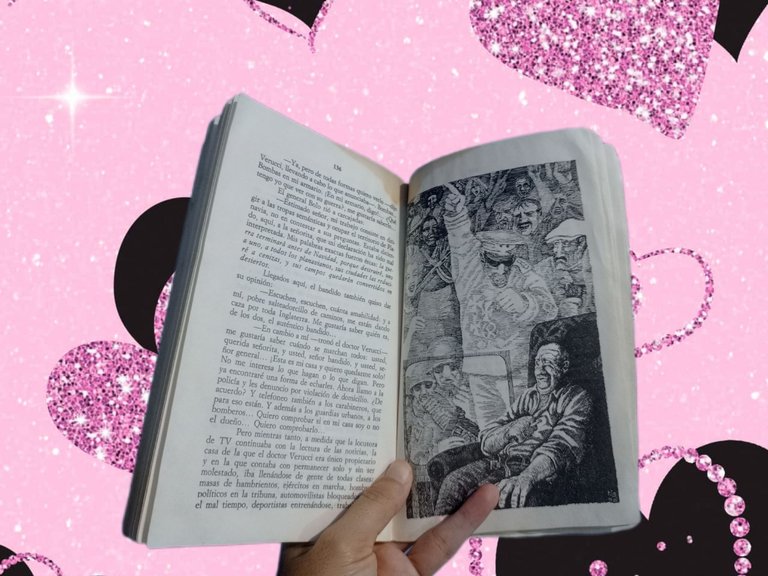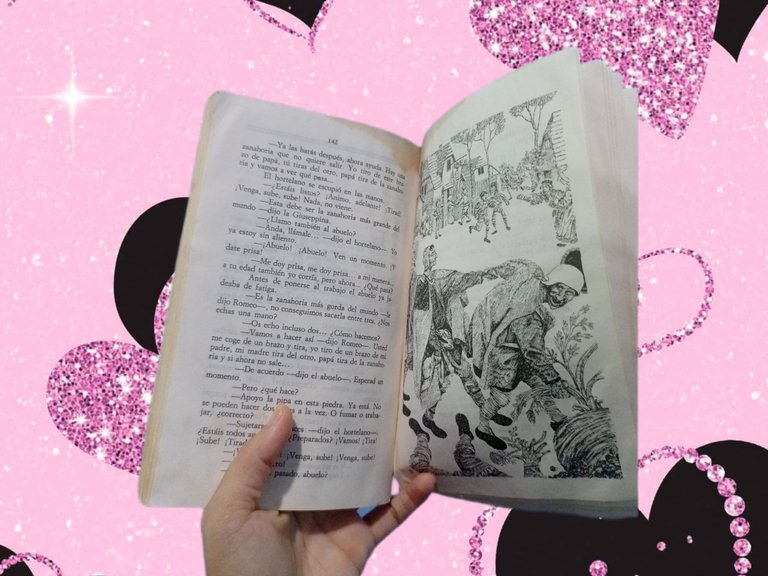Gianni Rodari has taken us through different adventures in recent days, a fascinating universe that has managed to stimulate the imagination of children and adults, which is a privilege considering that reality is saturated with technology. The scenarios presented are provided with multiple magical elements, which invite us to conceive mental images possible only within that world. To argue my post I will give my opinion on three stories.

When a child of months old presents a strange condition, it triggers a state of alertness, especially in his parents. This is the theme we find in Tino's disease. However, the structure of the story is deeper than it seems because it uses themes such as loneliness and depression. The story begins with Giovanni Batista, who was called Tino, being a child who could not be left alone because he was getting smaller, but when he felt accompanied he returned to normality. The doctor recommended that he should always be with someone so that he would not develop such an anomaly. Twenty years went by with his parents, friends and classmates, but one day he was left alone in his room.
One of the outcomes raises the idea that Tino has not been cured, not even the passage of time and friends have been able to eradicate his condition. His parents observed that he had become a child again, they took him to the doctor and this time the treatment is that he should get married and have many children, so that he will feel accompanied every day. On the other hand, the second ending makes an interesting reflection, Tino has managed to heal because those who have true friends and projects are never alone, they are in his mind and heart, reaffirming that loneliness is a feeling and not a state of absence. In the last ending, the protagonist presents a variant of the disease, that is, the lonelier he gets, the more he grows. This ending is reflective, although young people aim to be taller than their parents, especially if they practice sports, in this case it alludes to people who conceive great ideas from their loneliness.

Later, in the story Adventure with the TV set we find a scathing criticism of the media, which can hypnotize us to the point of blocking our individual thoughts. At the beginning, the narrator plays an amusing game and makes the reader an accomplice to help him build the character of Dr. Verucci and also place him in the front row, just like in the movies, to show the events. Verucci observes how what is narrated by the TV anchorwoman comes out of the TV set to settle in his house, including herself. In this story the author points out his position towards newscasts and wars.
In the first alternative ending, Dr. Verucci denounces to the police the invasion of people coming out of the television set, so the representatives of the law take them all to jail. The second ending points to sanity, tranquility and emotional stability, Dr. Verucci turns off the TV set and the problems disappear. The last ending is melancholic and somewhat empathetic. The conflicts of the world will always be there, even if the media present another reality or we simply ignore them.

To conclude this review, we have the tale The Great Carrot, whose story is a version of a traditional Russian tale. An old farmer harvests carrots and one day discovers that one of them is huge, so huge that he needs all the help he can get to dig it out of the ground.
In the first proposed ending there is a carrot so big that it crosses the planet, for this reason from the other end they are also trying to pull it out, causing a competition of strength. The second ending borders on the absurd, as it turns out that they manage to pull it out, but it was not a carrot but a pumpkin. On the other hand, in the last ending they manage to remove the carrot after a great collective effort that required the participation of the whole town, it was so big that 27 trucks and a tricycle were needed to take it to the market. Here we see an allegory of the original denouement, that of the Russian fairy tale, where the strength of a mouse is the addition required to achieve the goal.

Again, Rodari tackles deep themes and molds them to children's literature, which works to create thoughtful stories about the vicissitudes of life. There will always be conflicts and problems in the world, in any era, so it is rewarding to delve into the stories because there you can find different versions of world history than what is offered in academic texts, and I love that.
Versión en EspañolGianni Rodari nos ha llevado por diferentes aventuras en los últimos días, un universo fascinante que ha logrado estimular la imaginación de pequeños y adultos, lo que es un privilegio considerando que la realidad está saturada de tecnología. Los escenarios planteados están provistos de múltiples elementos mágicos, los cuales nos invitan a concebir imágenes mentales posibles solo dentro de ese mundo. Para argumentar mi post opinaré sobre tres cuentos.

Cuando un niño de meses de nacido presentó una extraña condición, se desencadenan estados de alerta, sobre todo en sus padres. Este es el tema que encontramos en La enfermedad de Tino. Sin embargo, la estructura del relato es más profunda de lo que parece porque utiliza temas como la soledad y la depresión. La historia comienza con Giovanni Batista, al que llamaban Tino, siendo un niño al que no podían dejar solo porque empequeñecía, al sentirse acompañado regresaba a la normalidad. El doctor recomendó que siempre estuviera con alguien para que no se desarrollara tal anomalía. Transcurrieron 20 años junto a sus padres, amigos y compañeros de estudio, pero un día es dejado solo en su habitación.
Uno de los desenlaces plantea la idea de que Tino no se ha curado, ni siquiera el pasar del tiempo y los amigos han podido erradicar su condición. Sus padres observaron que de nuevo regresó a ser niño, lo llevaron al médico y en esta ocasión el tratamiento es que se case y tenga muchos hijos, así se sentirá acompañado todos los días. En cambio, el segundo final hace una interesante reflexión, Tino ha logrado curarse porque quien tiene amigos verdaderos y proyectos nunca está solo, ellos están en su mente y corazón, reafirmando que la soledad es un sentir y no un estado de ausencia. En el último final, el protagonista presenta una variante de la enfermedad, es decir mientras más solitario más crece. Este final es reflexivo, si bien los jóvenes apuntan a tener una altura superior a sus padres, sobre todo si practican deportes, en este caso alude a las personas que a partir de su soledad conciben grandes ideas.

Posteriormente, en el cuento Aventura con el televisor nos encontramos con una crítica mordaz hacia los medios de comunicación, los cuales pueden llegar a hipnotizarnos hasta bloquear los pensamientos individuales. Al inicio, el narrador hace un juego divertido y vuelve cómplice al lector para ayudarlo a construir el personaje del Dr. Verucci y además ubicarlo en primera fila, tal como en el cine, para mostrar los acontecimientos. Verucci observa cómo lo narrado por la presentadora de la televisión sale del aparato para instalarse en su casa, incluso ella misma. En este relato el autor señala su posición hacia los noticieros y las guerras.
En el primer final alternativo el Dr. Verucci denuncia ante la policía la invasión de personas que salen del televisor, así que los representantes de la ley se llevan a todos a la cárcel. El segundo final apunta a la sensatez, a la tranquilidad y a la estabilidad emocional, el Dr. apaga el televisor y desaparecen los problemas. El último final es melancólico y resulta un tanto empático. Los conflictos del mundo siempre estarán allí, aunque los medios presenten otra realidad o simplemente los ignoremos.

Para concluir esta reseña, tenemos el cuento La gran zanahoria, cuya historia es una versión de un relato tradicional ruso. Un viejo campesino cosecha zanahorias y un día descubre que una de ellas es inmensa, tanto que requiere de toda la ayuda que le puedan prestar para extraerla de la tierra.
En el primer final propuesto se presenta una zanahoria tan grande que atraviesa el planeta, por tal razón desde el otro extremo también están tratando de sacarla, originando una competencia de fuerza. El segundo final raya en lo absurdo, pues resulta que la logran sacar, pero no era una zanahoria sino una calabaza. Por otra parte, en el último final logran sacar la zanahoria tras un gran esfuerzo colectivo que requirió la participación de todo el pueblo, era tan grande que se requirieron 27 camiones y un triciclo para llevarla al mercado. Aquí se advierte una alegoría del desenlace original, el del cuento ruso, donde es la fuerza de un ratón la adición que se requiere para lograr el objetivo.

Nuevamente, Rodari aborda temas profundos y los amolda a la literatura infantil, lo que funciona para crear relatos reflexivos sobre los avatares de la vida. Siempre existirán conflictos y problemas en el mundo, en cualquier época, por ello resulta gratificante indagar en las narraciones puesto que allí se pueden encontrar versiones de la historia universal distintas a las que se ofrecen en textos académicos y eso me encanta.
✓Photos from my personal gallery, edited with Fotocollage.
✓Text translated with DeepL.
🌜💗🌜💗🌜💗🌜💗🌜💗🌜
✓Fotos de mi galería personal, editadas con Fotocollage.
✓Texto traducido con DeepL.
Posted Using INLEO